[Wanderlust Tips August 2019] Landing at Hamad International airport amidst the sunny and windy desert of the Middle East, i was surprised to see the raindrops on the plane window. In my mind, the rain rarely fell in the desert lands or had i just been lucky. Anyhow, i was wrong, it turns out that the desert also has a winter, in recent years the winter temperature in Qatar has dropped below 10°c and heavy downpours have flooded the streets. My Qatar experience started with such a wonderful surprise.
[rpi]

DOHA: PAST AND FUTURE
The capital of Doha is likened to a picture reflecting the stages of time: past and future. Find yourself wandering through every period along several kilometres stretch through Doha Bay. The residents’ traditional wooden boats used to be a means of economic development for fishing and catching pearls, but now they are mainly to serve tourists who want a different kind of experience, one that means they can float peacefully in the bay and listen to the waves gently lapping whilst enjoying Arabian musical melodies – a rich blend of Doha’s ancient and modern ambience. Sitting on the boat and looking at the towering skyscrapers built in different shapes and colours – many believe that they resemble Hong Kong, Shanghai or New York! From my perspective, they bear a distinctive beauty of Doha, Qatar and I was honestly mesmerised to think that this skyline of soaring buildings was only built around 20 years ago. The place was formerly a vast arid desert, so it is undeniable that Qatar is indeed a thriving country, where “wise investment” is key with the construction industry moving at a dizzying pace.
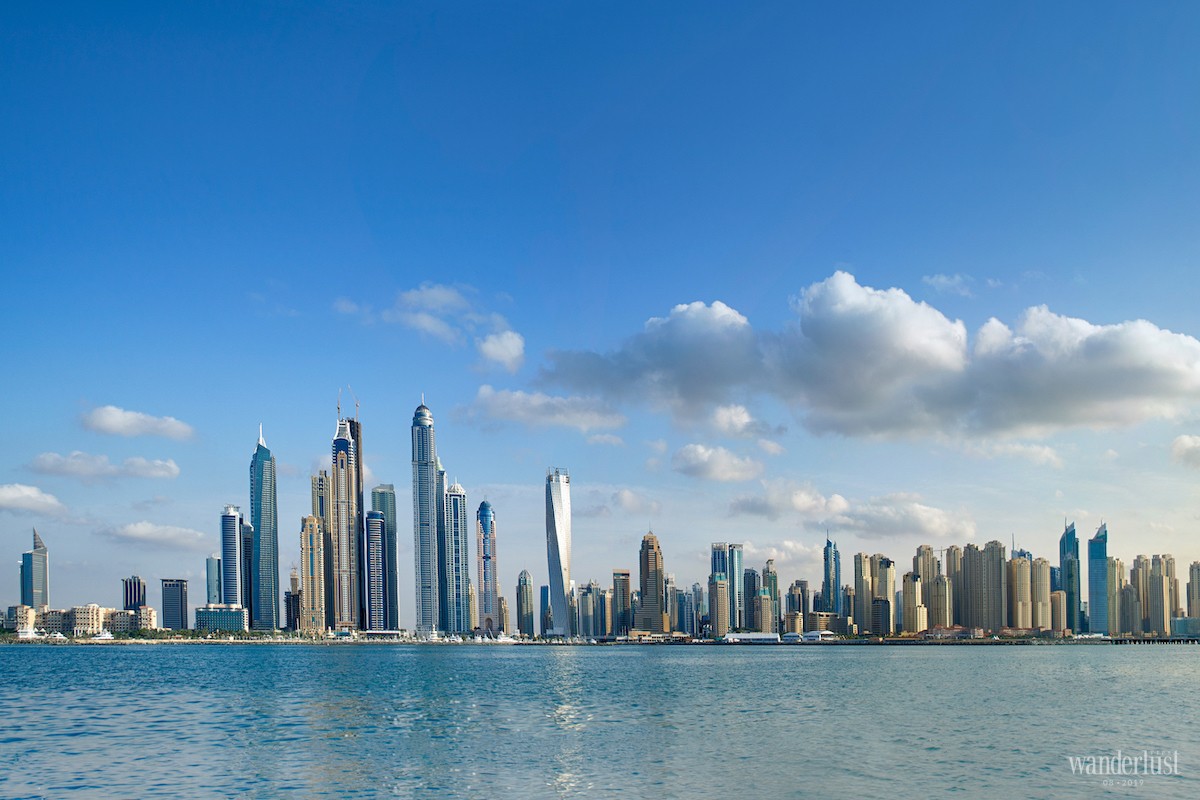
The ancient market of Souq Waqif – a former representative of Doha, is dubbed the most beautiful ancient market in the Middle East, featuring an archaic Arab architecture that has been thoroughly preserved and remodelled. The Souq Waqif has deftly recreated the scenery of the ancient Persian market, taking visitors on a mysterious journey through “The Arabian Nights”. The countless intersecting lanes boast an array of grocery stores with souvenirs, antiques, indigenous clothing, Arab spices and pets. The Souq Waqif is most beautiful at night when the shops light up, creating a sparkling space.
If you are a Hanoian, you might fully be able to appreciate the feeling of sipping a cup of coffee and a cigarette whilst observing the surrounding streets of Ho Guom in the evenings. In Doha, you can enjoy the Arab aroma of shisha and devour a cup of karak, a type of Arabian milk tea, on the old streets of the Souq Waqif while indulging in the buzzing atmosphere of the Persian market and the traditional dance on the street.
THE GREAT PRIDE OF QATARI RESIDENTS
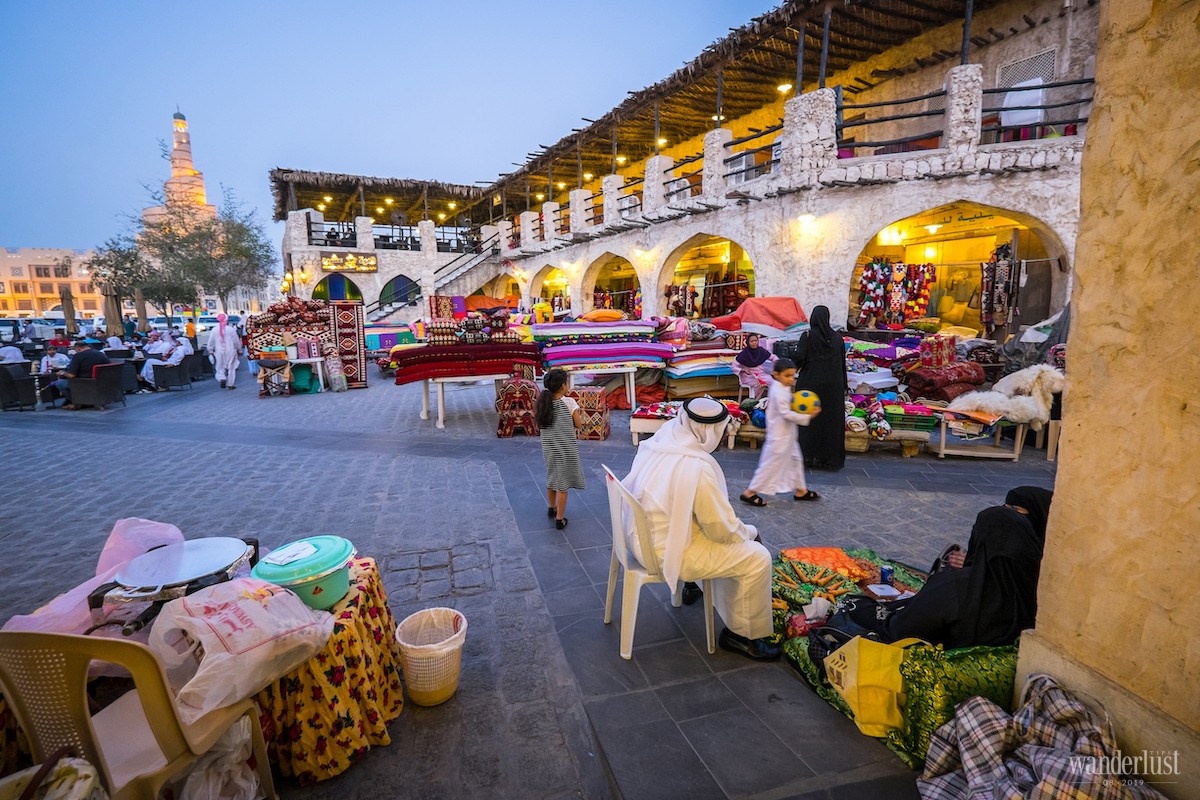
I went to a place that only exists in rich Middle Eastern countries while getting lost in the pristine small alleys. It was the Falcon Hospital, which embodies the life of luxury for Qatar’s upper classes, the thobe-shirt-wearing boys were holding proud falcons on their hands. Having falcons is both an expensive hobby and a pride of Arab boys passionate about the falconry. A fully grown falcon could set you back around QAR250,000 (about VND1.5 billion). The falcons have exceedingly good hearing and can see 10 times further than humans, hence their eyes are always covered to prevent any reaction to visual stimulation and only taken off when they are ready to hunt. For falcons, hunting is innate. The falconry came from Iran over 5,000 years ago and was then brought to Qatar by the Bedouin tribe living in the desert.
In addition to the pride of the pet falcons, the Qatari menswear – Thobe, is the great pride of Qatari residents. The Thobe is a white long robe or tunic with a tailored collar like a shirt. The shirt collar is not only a distinctive feature of the traditional Qatari Thobe but also an important factor so that you can distinguish between the Qatari Thobe and neighbouring countries’ Thobe’s such as Oman (round neck), UAE (round neck), or Kuwait (square neck).
CROSSING OVER THE SAND DUNES
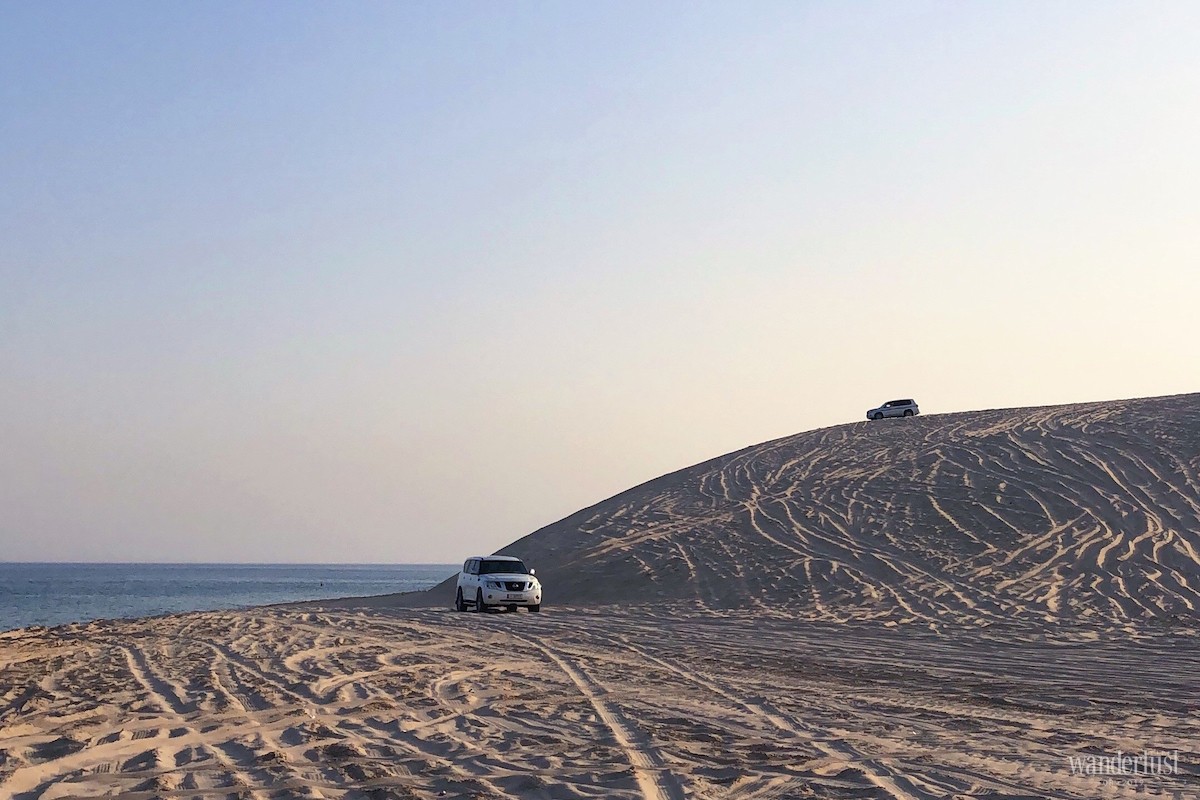
You can not visit Qatar and not visit the desert. You must experience the feeling of driving on the sand dunes – both a kind of adventure sport and a popular tourist activity in the Middle East. Ali – the Egyptian tour guide took us to Sealine Beach 70km away from Doha on a sunny afternoon. While waiting for Ali to pump up the wheels to be able to race on the sand dunes, we took the opportunity to take a 15-minute camel ride for QAR20 (= VND120,000). I sat on the back of the camel watching as the most breath-taking sunset silhouetted the horizon where the sky meets the sea and the last rays of the sunset bathed the sand dunes in a sparkling yellow. It was indeed one of the most peaceful natural scenes I have ever had the opportunity to enjoy.
When Ali’s Land Cruiser was ready to go, we began our journey to explore the desert. We climbed the towering white sand dunes, which are so tall that we couldn’t see the top, but it did not take too long to reach the highest point. From its towering top, we took in the spectacular views over the desert with sand dunes stretching endlessly like waves lapping on the mainland.
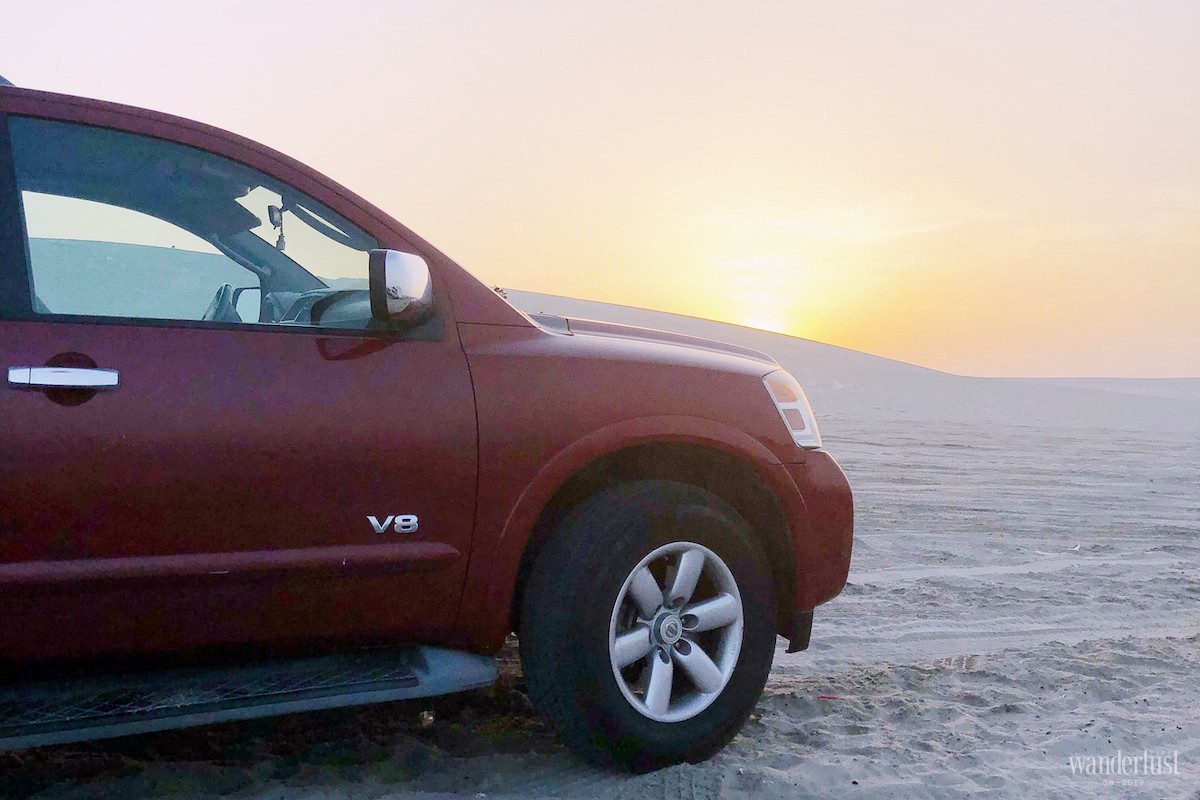
Ali is an excellent four-wheel driver. He controlled the car skilfully at a breakneck speed and darted straight through sand dunes which are taller than 10-storey buildings to sand basins. He drove the car at a tilt of 45 degrees, with the towering sand dunes on one side and the crystal-clear Inland Sea on the other side, it made our hearts skip a beat as we screamed with excitement. Ali stopped the car by the top of the highest dune, so that we could take pictures of the sunset standing out against the deep blue sky and the magnificently vast Inland Sea. The Inland Sea or Khor Al Adaid is the only sea in the world created thanks to high sea level and marine transgressions from the Arabian Gulf.
Our footprints made their mark in the smooth white sand, but a gust of sandy wind blew them away after only a few seconds. This was the first time I had seen the sunset from such a close distance, the purple and pink rays of sunshine at dusk spread across the enchanting horizon. I grabbed a handful of sand and let the wind whisk the grains through my fingers towards the bright red sun.
DOHA AND THE HOMESICK DRIFTERS
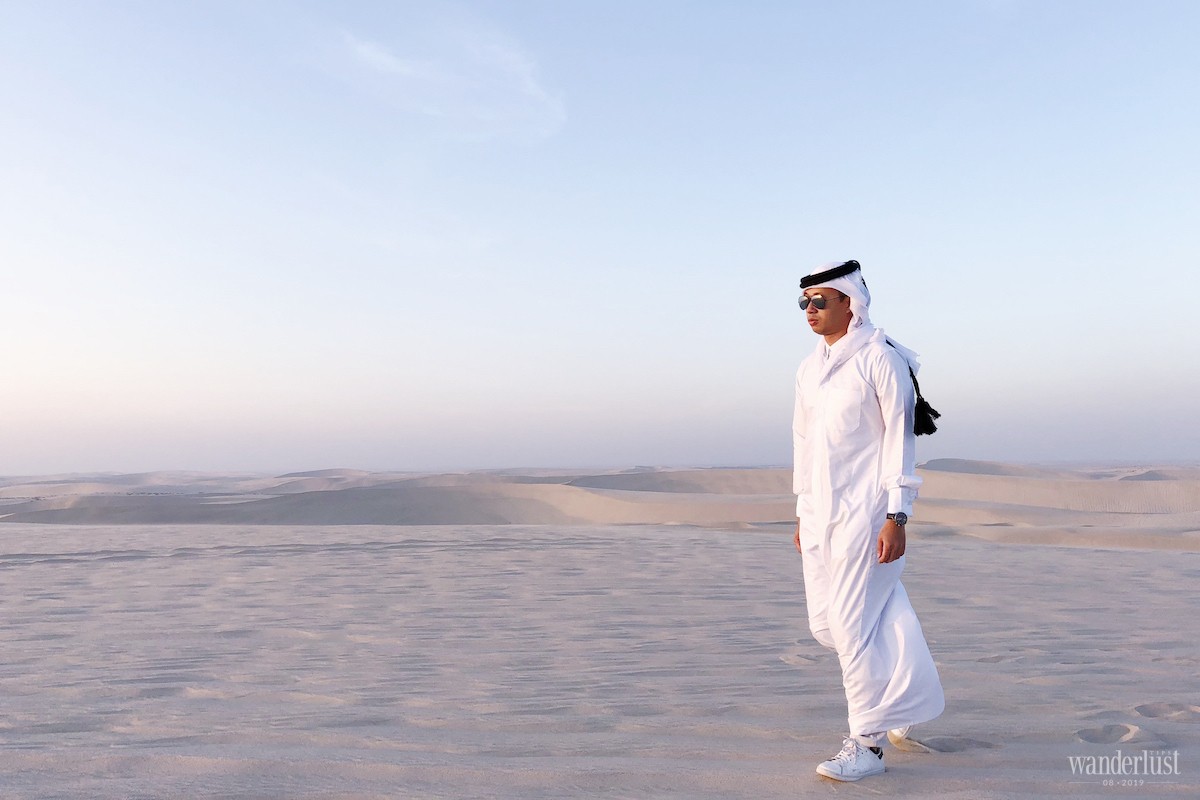
My last experience in Doha is not really like that of a tourist. Two Vietnamese friends drove me across the Corniche – a 7km coastal road that features almost all of Qatar’s iconic architectural masterpieces such as the Emiri Diwan Royal Palace, the National Museum, the Museum of Islamic Art and Doha Tower to name a few. The car then turned into a lightless street, we stopped at a mobile tea shop to buy three cups of karak tea and a chapati cake (the Arabic-styled bread is different from Indian style). The car continued towards a crowded place at the end of the road. This is essentially an abandoned jetty, which is now waveproofed by concrete embankments and only known by people living in Doha.
We climbed the breakwater and looked for a position. People here sit in groups, in pairs or simply alone. Most of them are foreigners who are living and working in Qatar (more than 94% of Qatar’s population is foreign settlers). Deriving largely from European countries and North America, the foreign population have moved to Qatar – the land of the desert, because of the opportunities to work and live in a better environment and earn higher wages. Although wherever they come from, they surely feel a sense of longing for their hometown and for their family. When they do, they will come to this embankment on the deserted island surrounded by waves, they can sit and chat while sipping a cup of karak tea with the signature aroma of ginger and the exquisite taste of tea. They will immerse themselves in the darkness and admire the dazzlingly colourful landscape of the vibrant city of Doha – the city they now call home despite feeling homesick for the place in which they were born.
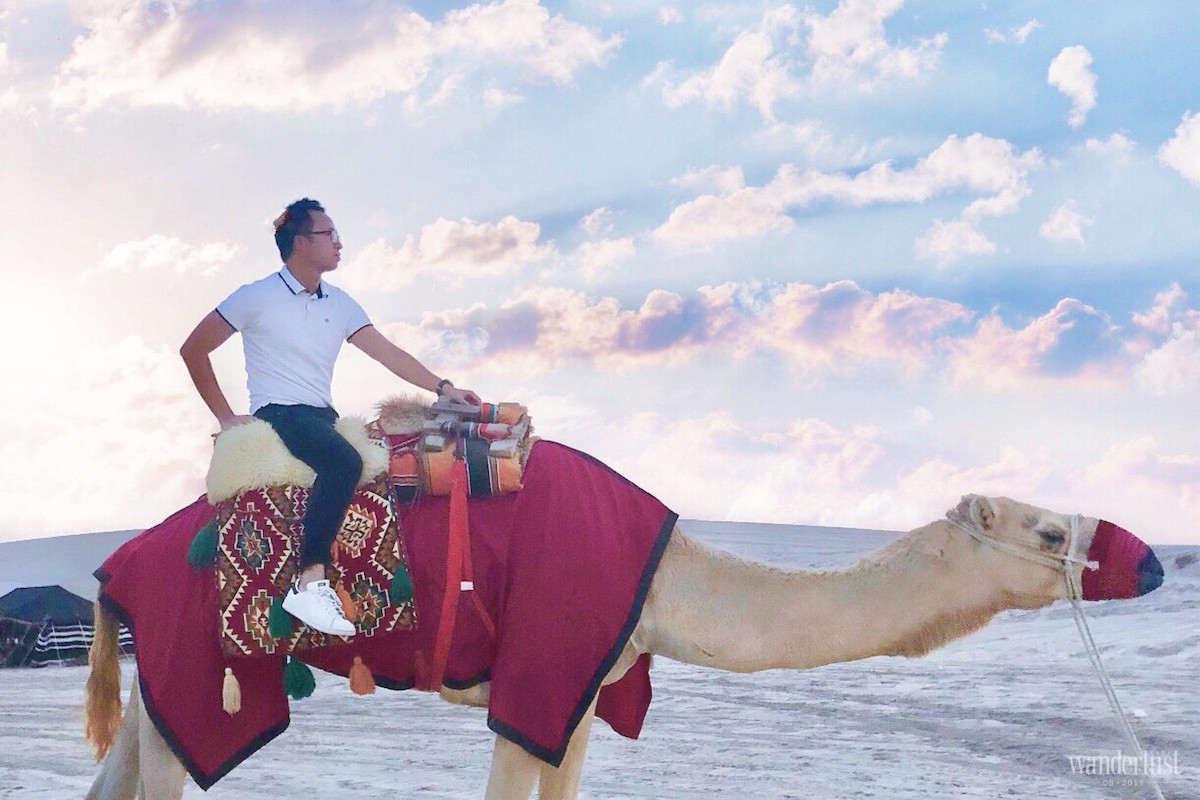
W.TIPS
![]()
GENERAL INFORMATION
In the early 20th century, Qatar was a poor country where residents mainly lived off the local industry of hand-crafted pearl catching from wooden boats. In the 1950’s and 60’s, under the rule of Britain, Qatar began to get rich thanks to oil exportation. In 1971, Qatar was granted independence. Since becoming an independent country, Qatar has progressed staggeringly to have the highest GDP in the world. From a rudimentary white pearl, Qatar has gradually become a precious gem possessing a great value amongst the Middle Eastern countries, thoroughly deserving its position as the perfect destination for tourists to visit and explore.
![]()
CLIMATE
The best time to travel to Qatar is in winter from November to March respectively. The average temperature ranges from 18°C to 28°C, making it suitable for city tours. In winter, temperatures in desert areas drop below 10°C at night, so please ensure to wear warm clothing if you stay in camps in the desert. Tourists should consider that when travelling to Qatar in the height of summer (from June to July) the daytime temperatures rise above 50°C.
![]()
TRANSPORTATION
>> Travelling to Qatar: Currently, from Vietnam, you can take weekly flights from Hanoi or Ho Chi Minh City to Qatar. Flight time is approximately 7 hours.
>> Travelling around Qatar: Taxis or Ubers are popular in Qatar. The bus service is quite modern, but people don’t opt for use due to the outdoor waiting station and few bus stops, which can be quite inconvenient in the summer. From the airport to the city centre, you can take a taxi or Uber for around USD15 to USD20 depending on hotel location.
![]()
CURRENCY
The currency used in Qatar is Riyal Qatar with a rate of QAR1 = VND6,500, USD1 = QAR3,65. Exchanging money is easy as long as you have your passport. You can exchange money at the airport, hotel or tourist destinations for a good exchange rate. Additionally, you can use credit cards at many tourist destinations, restaurants, or shopping centres.
![]()
SHOPPING
The shopping centres are considered the pièce de résistance in Qatar. Due to the hot summer, Qatar has built a wide range of shopping centres integrated with entertainment and dining venues around Doha to serve residents as well as tourists.
>> Villagio Mall: built to simulate the Italian city of Venice with colourfully-decorated houses and a canal located within the commercial centre. Villagio is a large shopping centre containing an array of fashion brands ranging from high street to luxury. This is also a hot spot for tourists.
>> Being a member of a chain of French commercial centres, Galeries Lafayette is located in Katara Cultural Village with high-end fashion brands. In particular, Galeries Lafayette is fully equipped with state-of-the-art outdoor air conditioning system that makes the temperature around this area less than the actual temperature by 5°C to 7°C, creating favourable conditions for tourists to shop on unbearable summer days.
>> Al Hazm is a shopping and dining centre built entirely from marble in a European style. The place is a melting pot for high-end fashion brands and is considered Qatari elite’s shopping venue.
>> Doha Festival City houses IKEA.
>> Some other shopping venues include Mall of Qatar and Ezdan Mall.
![]()
CUISINE
Qatari cuisine bears resemblance to the cuisine of Islamic Arab countries in the Middle East with delicacies such as grilled lamb thighs, stewed lamb rice and salads.
If you are passionate about sweets, please try a kunafa – a scrumptious Arabic cheese cake.
![]()
TOURIST DESTINATIONS IN DOHA
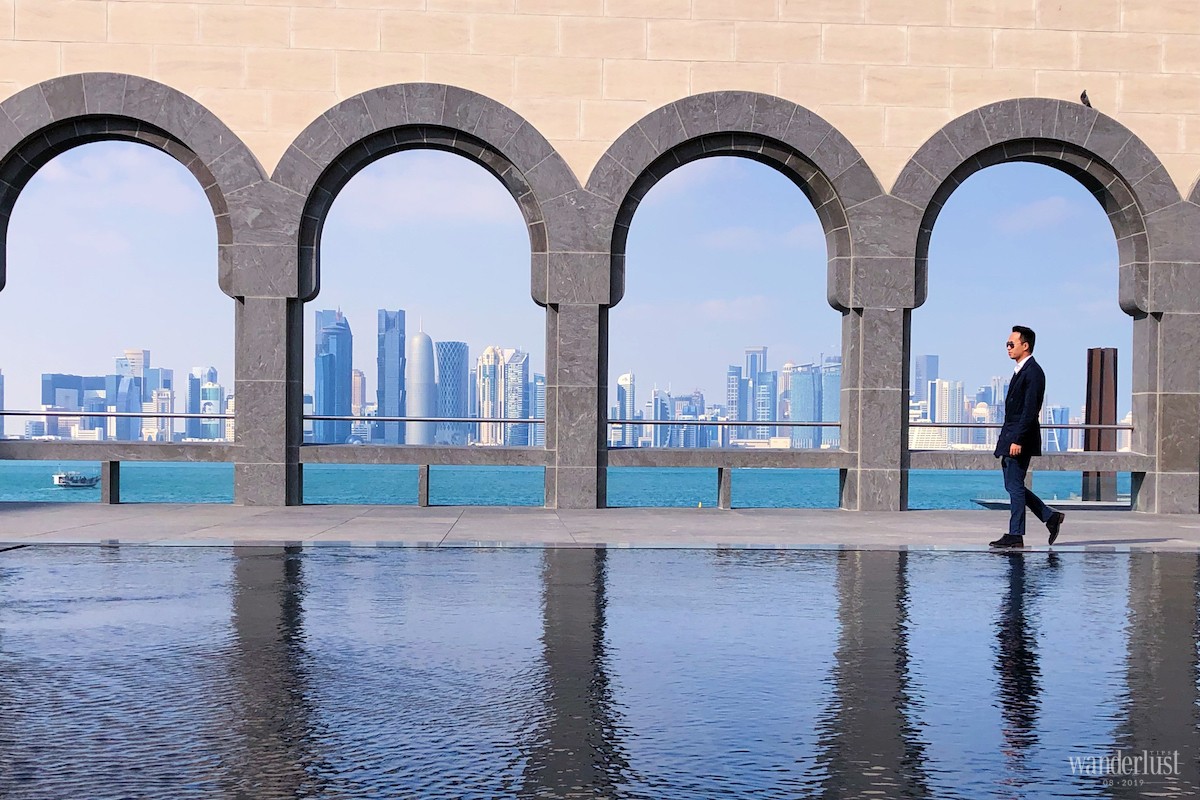
Some famous museums for tourists visiting Doha are named as below:
>> Katara Cultural Village is a complex of cultural architectures from different regions in the world such as Arab, Roman and modern European there is also an array of exhibition rooms housing pictures, art and culture.
>> The National Museum of Qatar is one of the most unique pieces of architecture in the world and is modelled after a rocky rose in the desert. The museum was completed after nearly a decade of construction for an estimated USD450 million. National Museum of Qatar will give visitors an insight into Qatari cultural exchange, inheritance and future development.
>> The Museum of Islamic Art brings an impressive collection of Islamic culture and art. Interestingly, the museum is located in the middle of Doha Bay, so visitors here can admire the stunningly beautiful scenery. On one side is a modern city with skyscrapers while the other overlooks an ancient market preserving the distinctive beauty of the traditional culture.
>> Sheikh Faisal Bin Qassim Al Thani Museum is one of the largest private museums in the world with collections of unique artefacts. It takes around 30 minutes from the museum to the city centre by taxi.
![]()
ACCOMMODATION
There are many hotels around the Souq Waqif with affordable prices. From here, tourists can easily walk to the antique market.
For those who prefer to stay in high-class hotels, the City Centre will be ideal with various five-star hotels.
Ha Nguyen | Wanderlust Tips


[…] to the designers, the floating hotel will initially be located in Qatar. When it is completed in Dubai, the project can also be located anywhere with the right current due […]
[…] Qatar: The precious pearl of the Middle East […]
[…] global airline to achieve the Skytrax COVID-19 Airline Safety Rating, while its home airport in Qatar – Hamad International Airport wins the award ‘World’s Best […]
[…] Qatar: The precious pearl of the Middle East […]